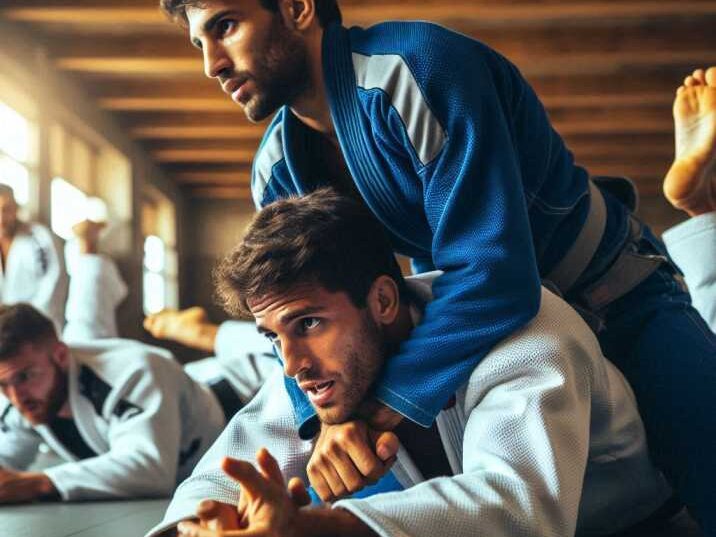Introduction
Table of Contents
Brazilian Jiu-Jitsu (BJJ) and Capoeira are two exciting martial arts with deep roots in Brazilian culture. Although they share a common origin, they are vastly different in terms of techniques, goals, and benefits. In this article, we’ll explore the differences between Brazilian Jiu-Jitsu and Capoeira, their training methods, and how both martial arts require concentration and discipline that can help improve focus in school and other activities. We will also provide valuable information for students who are interested in learning more about these two popular forms of martial arts.
What is Brazilian Jiu-Jitsu (BJJ)?
Overview of BJJ
Brazilian Jiu-Jitsu is a grappling-based martial art that focuses on ground fighting and submission techniques. The primary goal is to control and submit opponents using leverage and joint locks rather than brute strength. BJJ is widely known for its emphasis on self-defense, especially against larger and stronger opponents.

History of BJJ
BJJ originated from Japanese judo and jiu-jitsu techniques, which were brought to Brazil by Mitsuyo Maeda in the early 1900s. The Gracie family, particularly Helio Gracie, adapted and modified these techniques to create what we now know as Brazilian Jiu-Jitsu.
What is Capoeira?
Overview of Capoeira
Capoeira is a unique Brazilian martial art that combines dance, acrobatics, and music. It was developed by African slaves in Brazil as a way to disguise their self-defense training as a form of entertainment. The art is known for its fluid movements, rhythmic steps, and impressive acrobatic techniques.
History of Capoeira
Capoeira has its roots in African martial traditions, which were brought to Brazil during the slave trade. To avoid detection by slave owners, practitioners of Capoeira blended combat movements with dance-like motions. Today, Capoeira is recognized as a symbol of Brazilian culture and is practiced worldwide.
Comparing Brazilian Jiu-Jitsu and Capoeira
Techniques and Movement
Brazilian Jiu-Jitsu
- BJJ focuses primarily on grappling techniques like joint locks, chokes, and positional control.
- Movements are slow, calculated, and precise, with an emphasis on getting an advantageous position on the ground.
- BJJ is about staying close to your opponent, controlling their body, and using leverage to apply submissions.
Capoeira
- Capoeira, on the other hand, emphasizes fluidity and agility. The movements resemble dance, and the practitioners use kicks, sweeps, and acrobatics.
- The continuous movement in Capoeira, called Ginga, helps disguise attacks and makes it harder for opponents to predict what’s coming next.
- Capoeira relies on rhythm and timing, making it a more visually dynamic martial art compared to BJJ.
Training and Discipline
Both BJJ and Capoeira require discipline and intense focus. However, the training methods are quite different:
BJJ Training
- BJJ training is highly structured. Practitioners focus on drilling specific techniques, practicing on live opponents, and sparring (also known as “rolling”).
- BJJ fosters problem-solving skills since practitioners must adapt to their opponent’s movements and actions during sparring.
- Training in BJJ can be mentally challenging as it requires you to analyze situations and choose the right technique under pressure.
Capoeira Training
- Capoeira training often involves learning how to blend movements seamlessly with music, which improves coordination and rhythm.
- Capoeira classes often feature both physical training and musical practice, as music is an integral part of the art.
- The discipline in Capoeira comes from the ability to control your body’s movements and work as part of a team, particularly during a Capoeira “roda,” where students perform in a circle.
Health Benefits of BJJ and Capoeira
BJJ Health Benefits
- BJJ is excellent for strengthening the body, particularly the core muscles and legs.
- It improves cardiovascular endurance and flexibility, as practitioners constantly shift between positions.
- Mental benefits include enhanced problem-solving skills, patience, and resilience.
Capoeira Health Benefits
- Capoeira improves balance, coordination, and overall body strength due to its acrobatic nature.
- It promotes flexibility and agility, as students perform a variety of kicks, jumps, and spins.
- The rhythmic nature of Capoeira can help relieve stress and improve mental clarity.
Self-Defense: BJJ vs Capoeira
Brazilian Jiu-Jitsu for Self-Defense
- BJJ is widely regarded as one of the most effective martial arts for self-defense. Its focus on grappling and submissions allows practitioners to neutralize attackers without causing significant harm.
- BJJ is particularly useful in real-world situations because it teaches you how to defend yourself from the ground, which is where many altercations end up.
Capoeira for Self-Defense
- While Capoeira can be effective for self-defense, its focus on acrobatic and flashy movements may not always be practical in real-world situations.
- However, Capoeira’s unpredictability and agility can be a valuable asset in self-defense, especially when paired with other martial arts.
Which is Right for You?
When choosing between Brazilian Jiu-Jitsu and Capoeira, it comes down to personal preference and your goals:
- If you’re interested in a martial art that focuses on grappling and self-defense, Brazilian Jiu-Jitsu may be the right choice.
- If you prefer an art that emphasizes dance, rhythm, and acrobatics, Capoeira might be more appealing.
- Both arts require dedication, discipline, and concentration, which can benefit other areas of life, including school and hobbies.
Table: Key Differences Between Brazilian Jiu-Jitsu and Capoeira
| Aspect | Brazilian Jiu-Jitsu (BJJ) | Capoeira |
|---|---|---|
| Focus | Grappling, submissions, and self-defense | Kicks, sweeps, acrobatics, and rhythm |
| Training | Drilling techniques and sparring | Movement, rhythm, and acrobatic drills |
| Origin | Japan/Brazil (early 20th century) | Africa/Brazil (slave era) |
| Movement Style | Close-range, calculated, and controlled | Fluid, dance-like, and unpredictable |
| Health Benefits | Strength, endurance, flexibility | Coordination, flexibility, balance |
| Self-Defense | Excellent for real-world self-defense | Less practical, more unpredictable |

Conclusion
In conclusion, Brazilian Jiu-Jitsu and Capoeira are two fascinating martial arts that offer unique experiences for practitioners. While BJJ focuses on grappling and submissions, Capoeira emphasizes acrobatic movements and rhythm. Both arts require discipline, concentration, and physical fitness, making them beneficial for mental and physical health. Whether you choose Brazilian Jiu-Jitsu or Capoeira, the skills learned can translate into improved focus in school and other activities, providing benefits beyond the martial arts arena.
FAQs
1. What is Brazilian Jiu-Jitsu (BJJ)?
Brazilian Jiu-Jitsu is a grappling-based martial art that focuses on ground fighting, control, and submissions.
2. What is Capoeira?
Capoeira is a Brazilian martial art that blends dance, music, and acrobatics, developed by African slaves in Brazil.
3. Which martial art is better for self-defense, BJJ or Capoeira?
Brazilian Jiu-Jitsu is generally considered better for self-defense due to its emphasis on submissions and ground control.
4. Are BJJ and Capoeira good for kids?
Yes, both martial arts are great for kids. BJJ develops discipline and problem-solving skills, while Capoeira enhances coordination and rhythm.
5. Can I learn both BJJ and Capoeira?
Absolutely! Many people train in both arts, as they complement each other with their unique techniques and approaches.


